Countries in Southern Europe
How Many Countries in Southern Europe
As a region of Europe, Southern Europe is composed of 16 independent countries (Albania, Andorra, Bosnia and Herzegovina, Croatia, Greece, Holy See, Italy, Malta, Montenegro, North Macedonia, Portugal, San Marino, Serbia, Slovenia, Spain, Turkey) and 1 territory (Gibraltar). See below for the list of South European countries and dependencies by population. Also, you can find all of them in alphabetical order at this end of this page.
1. Albania
Albania is a republic in southern Europe in the Balkans and borders Montenegro, Kosovo, Macedonia and Greece. The capital of Albania is Tirana and the official language is Albanian.
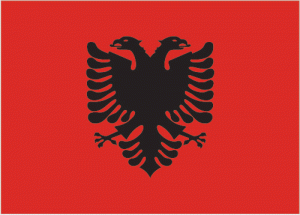 |
|
2. Andorra
Andorra is a small principality in southwestern Europe on the border between Spain and France. The capital is Andorra la Vella and the official language is Catalan.
 |
|
3. Bosnia and Herzegovina
Bosnia and Herzegovina is a Federal Republic of Southern Europe in the Balkans bordering Croatia, Serbia and Montenegro. The country has a little more than 3.8 million residents and is populated by three constitutional ethnic groups: Bosniaks, Serbs and Croats.
 |
|
4. Croatia
Croatia, formally the Republic of Croatia, is a republic in Central / Southeastern Europe. Croatia borders Bosnia-Herzegovina and Serbia to the east, Slovenia to the north, Hungary to the northeast and Montenegro to the south.
 |
|
5. Greece
Greece, formally the Republic of Greece, or the Hellenic Republic, is a republic in southern Europe in the Balkans. Greece borders Albania, Macedonia and Bulgaria to the north and Turkey to the east.
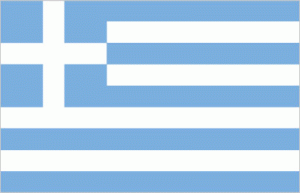 |
|
6. Italy
Italy, formally the Republic of Italy, is a unified parliamentary republic in southern Europe. Here on the country page, there are news, link tips, the latest news from the embassy, travel information from the Ministry of Foreign Affairs, our agents’ contact information, events in the country and the opportunity to contact Swedes living in Italy.
 |
|
7. Malta
Malta, formally the Republic of Malta, is an island nation in the central Mediterranean located between Libya in the south and Italy in the north. The country closest to the west is Tunisia and in a straight easterly direction is Greece with the island of Crete.
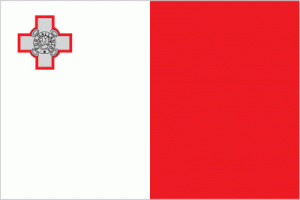 |
|
8. Montenegro
Montenegro is a republic located on the Adriatic Sea in southern Europe, in the Balkans. Montenegro borders Croatia and Bosnia and Herzegovina to the north, Serbia and Kosovo to the east and Albania to the south. The capital is Podgorica.
 |
|
9. Northern Macedonia
Macedonia, formally the Republic of Macedonia, has been a republic in southern Europe, in the Balkans, since the collapse of communism in the former Yugoslavia.
 |
|
10. Portugal
Portugal is a republic on the Iberian Peninsula in southwestern Europe.
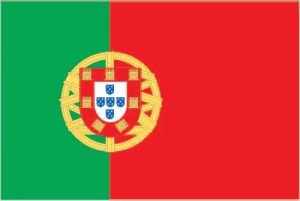 |
|
11. San Marino
San Marino, formally the Republic of San Marino, is a republic located on the Apennine Peninsula in southern Europe, completely enclosed by Italy. San Marino is one of Europe’s microstates. Its residents are called sanmarinier.
 |
|
12. Serbia
Serbia, officially the Republic of Serbia, is a state in the Balkans in southern Europe.
 |
|
13. Slovenia
Slovenia, formally the Republic of Slovenia, is a republic in Central Europe. The country borders Italy, Austria, Hungary and Croatia.
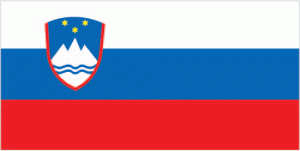 |
|
14. Spain
Spain, officially the Kingdom of Spain, is a country and Member State of the European Union located in southwestern Europe on the Iberian Peninsula.
 |
|
15. Turkey
Turkey, officially the Republic of Turkey, is a Eurasian country that stretches across the Anatolian Peninsula in southwest Asia and Eastern Thrace on the Balkan Peninsula in southeastern Europe.
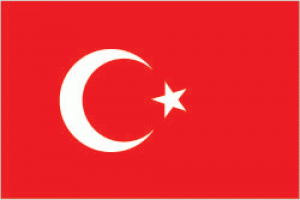 |
|
16. Vatican
Vatican City, is an independent microstat located as an enclave in the Italian capital Rome. Here on the country side, there are news, link tips, the latest news from the embassy, travel information from the Ministry of Foreign Affairs, our agents’ contact information, events in the country and the opportunity to contact Swedes living in the Vatican City.
 |
|
List of Countries in Southern Europe and Their Capitals
As noted above, there are 3 independent countries in the Southern Europe. Among them, the largest country is Turkey and the smallest is Holy See. The full list of Southern European countries with capitals is shown in the table below, ranked by latest total population.
| Rank | Independent Country | Current Population | Capital |
| 1 | Turkey | 82,003,882 | Ankara |
| 2 | Italy | 60,375,749 | Rome |
| 3 | Spain | 46,733,038 | Madrid |
| 4 | Greece | 10,741,165 | Athens |
| 5 | Portugal | 10,276,617 | Lisbon |
| 6 | Serbia | 7,001,444 | Belgrade |
| 7 | Croatia | 4,130,304 | Zagreb |
| 8 | Bosnia and Herzegovina | 3,301,000 | Sarajevo |
| 9 | Albania | 2,862,427 | Tirana |
| 10 | Slovenia | 2,080,908 | Ljubljana |
| 11 | North Macedonia | 2,075,301 | Skopje |
| 12 | Montenegro | 622,359 | Podgorica |
| 13 | Malta | 475,701 | Valletta |
| 14 | Andorra | 76,177 | Andorra la Vella |
| 15 | San Marino | 33,422 | San Marino |
| 16 | Holy See | 799 | Vatican City |
Territories in Southern Europe
| Dependent Territory | Population | Territory of |
| Gibraltar | 33,701 | U.K. |
Map of Countries in Southern Europe
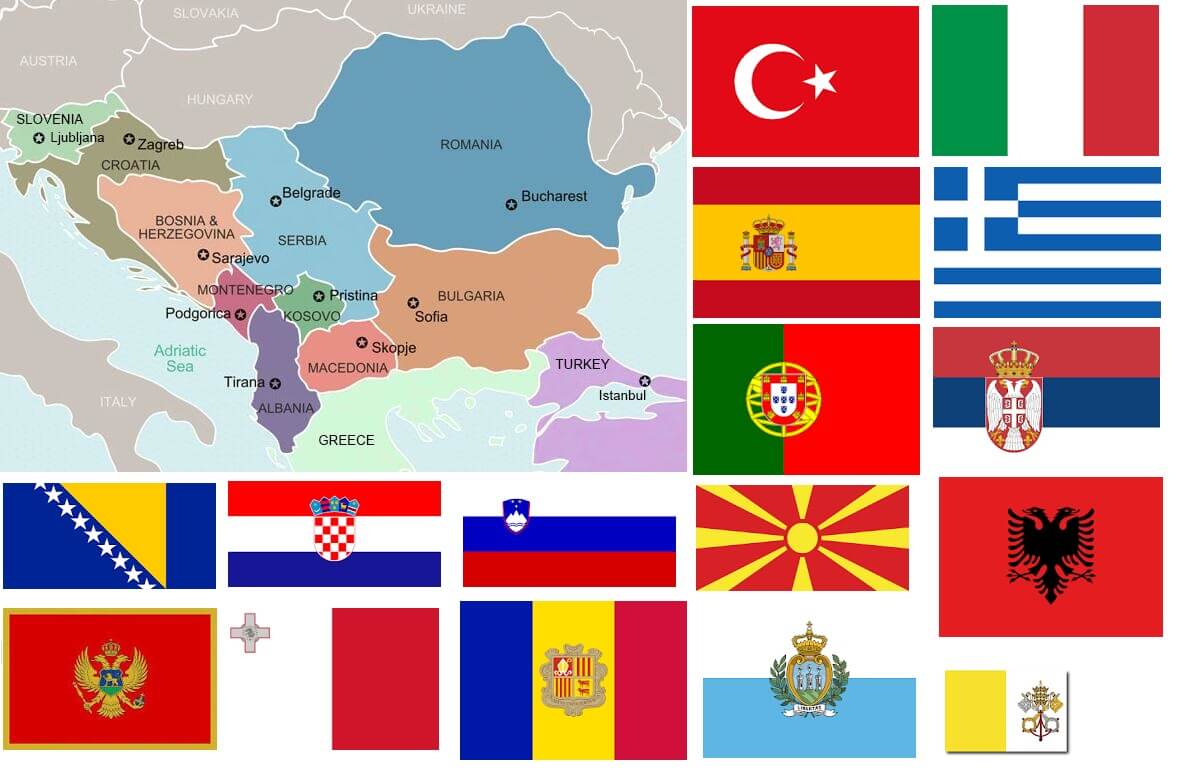
Alphabetical List of Countries and Dependencies in Southern Europe
In summary, there are a total of 17 independent countries and dependent territories in Southern Europe. See the following for full list of Southern European countries and dependencies in alphabetical order:
- Albania
- Andorra
- Bosnia and Herzegovina
- Croatia
- Gibraltar (U.K.)
- Greece
- Holy See
- Italy
- Malta
- Montenegro
- North Macedonia
- Portugal
- San Marino
- Serbia
- Slovenia
- Spain
- Turkey
Brief History of Southern Europe
Ancient Civilizations
Greece
Southern Europe, particularly Greece, is often regarded as the cradle of Western civilization. The Minoan civilization on Crete (c. 3000-1450 BCE) and the Mycenaean civilization on mainland Greece (c. 1600-1100 BCE) laid early cultural foundations. The Classical period (5th-4th centuries BCE) saw the rise of city-states like Athens and Sparta, significant for their contributions to democracy, philosophy, and the arts. Greek culture and political influence expanded dramatically under Alexander the Great (356-323 BCE), whose conquests spread Hellenistic culture across the Mediterranean and into Asia.
Rome
Parallel to the Greek developments, Rome was rising from a small city-state founded in the 8th century BCE. By the 3rd century BCE, Rome had started its transformation into a vast empire. The Roman Republic (509-27 BCE) and later the Roman Empire (27 BCE-476 CE) dominated Southern Europe and the Mediterranean for centuries. Roman law, engineering, and cultural achievements profoundly influenced Europe and the broader Western world. The Pax Romana (27 BCE-180 CE) marked a period of relative peace and stability across the empire.
Middle Ages
Byzantine Empire
With the fall of the Western Roman Empire in 476 CE, the Eastern Roman Empire, or Byzantine Empire, centered in Constantinople (modern-day Istanbul), continued to thrive. The Byzantine Empire preserved Roman and Greek traditions while developing its own unique culture, which significantly influenced Eastern Orthodox Christianity and the Slavic world. Notable emperors like Justinian I (527-565 CE) attempted to reconquer lost western territories and codified Roman law in the Corpus Juris Civilis.
Islamic Conquests
The 7th and 8th centuries brought significant changes to Southern Europe with the rise of Islam. The Umayyad Caliphate swiftly conquered much of the Iberian Peninsula, establishing Al-Andalus. This period saw remarkable advancements in science, culture, and architecture, with cities like Cordoba becoming centers of learning and cultural exchange.
Medieval Kingdoms and the Reconquista
The fragmentation of the Carolingian Empire in the 9th century led to the formation of several medieval kingdoms in Southern Europe. In the Iberian Peninsula, the Christian Reconquista began in earnest, aiming to reclaim territories from Muslim rule. By the late 15th century, the Christian kingdoms of Castile, Aragon, and Portugal had completed the Reconquista, culminating in the fall of Granada in 1492.
Renaissance and Early Modern Period
Italian Renaissance
The Renaissance, originating in Italy in the 14th century, was a period of renewed interest in classical antiquity, spurring unprecedented developments in art, science, and thought. Cities like Florence, Venice, and Rome became vibrant cultural centers. Figures like Leonardo da Vinci, Michelangelo, and Galileo Galilei made lasting contributions to various fields, shaping the course of Western civilization.
Age of Exploration
The 15th and 16th centuries marked the Age of Exploration, driven by Southern European powers like Portugal and Spain. Pioneers such as Christopher Columbus and Vasco da Gama expanded European horizons, leading to the discovery of the New World and sea routes to Asia. This era significantly boosted the economies and global influence of these nations but also initiated centuries of colonialism and its accompanying exploitation.
Modern Era
The Enlightenment and Revolutions
The Enlightenment of the 17th and 18th centuries, while pan-European, had notable impacts in Southern Europe. Enlightenment ideas about reason, individual rights, and governance influenced revolutionary movements. The Napoleonic Wars (1803-1815) reshaped political boundaries and sparked nationalist sentiments. The early 19th century saw the Greek War of Independence (1821-1830) and the unification movements in Italy (Risorgimento) and Spain.
Industrialization and Political Changes
Southern Europe experienced varied rates of industrialization in the 19th century. Italy and Spain faced significant challenges, with political instability and economic disparity hindering rapid industrial growth. Nevertheless, the latter part of the century saw progress, with new infrastructures like railways and improved agricultural practices.
20th Century Turmoil
The 20th century brought profound changes and challenges. World War I and II had devastating effects on Southern Europe. Fascist regimes rose in Italy under Mussolini and in Spain under Franco, leading to brutal civil conflicts and repression. The post-war period saw recovery and integration into broader European frameworks like the European Union.
Contemporary Developments
The latter half of the 20th century and the early 21st century have been characterized by economic development, democratization, and integration into the European Union. Southern Europe, encompassing countries like Italy, Spain, Greece, and Portugal, continues to grapple with economic challenges, political changes, and the impacts of globalization and migration. Nonetheless, the region remains a vital part of Europe’s cultural and historical tapestry.













































